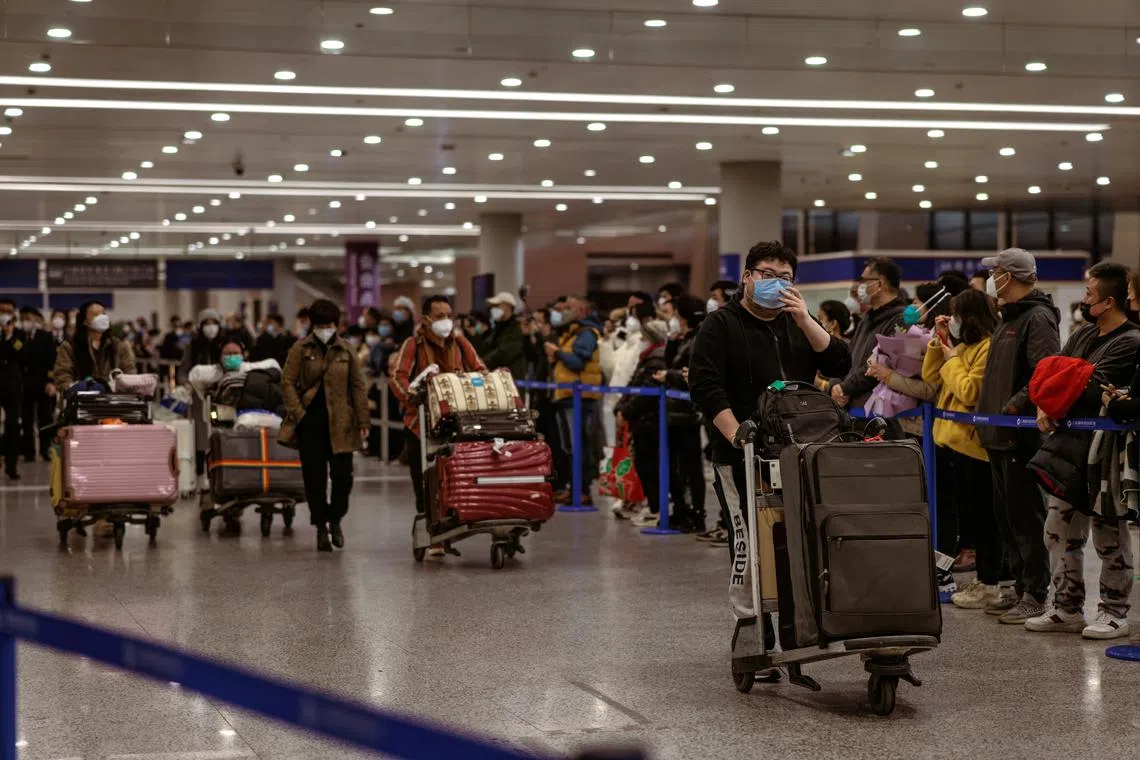China’s boost for flagging world economy looms as reopening starts
Sign up now: Get insights on Asia's fast-moving developments

Travellers from a Xiamen Airlines flight are greeted by Thai officials at Suvarnabhumi Airport in Bangkok on Jan 9, 2023.
PHOTO: AFP
Follow topic:
BEIJING – China’s sudden reopening is set to offer a boost to a flagging world economy.
The growth impulse will be felt through services sectors such as aviation, tourism and education as Chinese people pack their bags for global travel for the first time since the Covid-19 pandemic. Tourism-reliant nations in South-east Asia will likely be among the first to note a pick-up, with developed economies also benefiting from the return of Chinese visitors.
While China’s economic reboot is likely to be rocky, the dramatic Covid-19 shift coincides with efforts to shore up a real estate slump. That will give a lift to commodity producers like Chile and Brazil.
The impact is already flowing through financial markets. Copper prices have surged through US$9,000 a tonne for the first time since June, a gauge of Australian mining shares is honing in on an all-time high and the Chilean peso is enjoying its best streak of gains since August, all on China reopening bets.
The head of the International Monetary Fund last week described China’s pivot from zero-Covid as likely the single most important factor for global growth in 2023 and will mean China is a positive contributor to average global growth by around mid-year.
“China’s reopening will deliver a much-needed jolt to global growth,” said HSBC Holdings’ chief Asia economist Frederic Neumann. “As the second-largest economy in the world, accelerating Chinese household and investment spending will help put a floor under global trade at a time when demand in the West is faltering.”
For services, China expects the number of international flights to rebound to the equivalent of 15 per cent to 25 per cent of their pre-pandemic levels by end-March.
Barclays analysts including Dr Chang Jian expect a surge in outbound tourism and note data from Ctrip International that shows international travel bookings for the upcoming Chinese New Year holiday soared by 260 per cent against 2022. They say developed economies such as the United States, Britain and Australia will be among the beneficiaries.
Before Covid-19, China ran a US$260 billion (S$343 billion) services deficit, 85 per cent of which was due to outbound tourism, according to Barclays.
Tourist hot spots in South-east Asia including Thailand and Vietnam are also looking forward to a return of Chinese visitors. Thailand attracted around 11.5 million foreign visitors in 2022, way down from the 40 million before the pandemic in 2019 – when nearly a quarter were from China. The government expects 25 million foreign visitors this year.
At the same time, a domestic recovery in China will lend itself to firmer import demand and the purchases of foreign brands. S&P Global has forecast retail growth of 5.8 per cent in 2023.
Consumer confidence
For sure, China’s rebound is not expected to be linear.
How the public health crisis plays out remains to be seen, and it could yet leave a long shadow over consumer confidence. The big slump in property prices will weigh against a consumer rebound. And government stimulus, so far at least, has been quite restrained.
“When the Covid-19 situation settles down enough for China truly to reopen, probably around March, the reopening boomlet will disappoint in comparison to the developed market response,” said TS Lombard chief economist Freya Beamish. “Chinese domestic stimulus has been pale in comparison and the pool of wealth to support pent-up demand is much smaller.”
There is also a question around how China will impact global inflation. Bloomberg Economics estimates the reopening will push China’s 2023 gross domestic product (GDP) growth to 5.1 per cent, which would add about 0.9 percentage point to global inflation relative to what would happen if zero-Covid policies had continued.

Travellers arrive at Shanghai’s Pudong International Airport on Jan 8, 2023.
PHOTO: EPA-EFE
Policymakers are wary of how China may impact prices. Bank of Korea governor Rhee Chang-yong last week said that while China may boost his nation’s exports, it could also stoke inflation pressures. “If China’s economy is recovering fast, that might be good for the current account balance of Korea, but it may cause crude oil prices to rise,” he told reporters.
Still, for a world economy clasping for good news, a rebound in demand out of China will be welcomed. If the recovery plays out as expected, China may end up accounting for half of global growth, said Natixis’ chief Asia-Pacific economist Alicia Garcia-Herrero. “Given the meagre growth expected for the US and Europe, with downward risk of a recession for both, our expected 5.5 per cent GDP growth for China in 2023 – even if not impressive – will greatly contribute to global growth,” she said. BLOOMBERG

